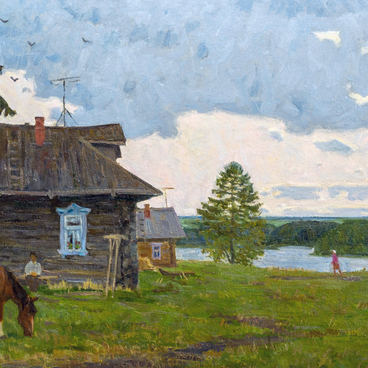A People’s Artist of the RSFSR, Honored Artist of the RSFSR, professor and honorary citizen of Kostroma, Alexey Pavlovich Belykh (1923–2017) was born in the village of Krutets, Oryol Oblast. He fought in the Great Patriotic War as an intelligence officer.
Later Alexey Belykh decided to become an artist. He studied at the Surikov Art Institute, under prominent professors — Fyodor Pavlovich Reshetnikov and Viktor Grigorievich Tsyplakov. Alexey Belykh became known to a wide audience when he presented such iconic works as “A Volga Woman” (1961), “Lumberjacks. Youth Brigade” (1964) and “Evening on the Volga” (1968).
The Kostroma artist Alexey Pavlovich Belykh mainly worked in the landscape genre. His rainbow palette glorified the banks of the Volga River, the nature of Central Russia, and the architectural monuments of Kostroma.
The artist’s works are kept in the central museums of Moscow, St. Petersburg, Chuhuiv, Yaroslavl, and Kostroma. The Zavolzhsk Art Gallery named after the People’s Artist Vladimir Telin also displays several works by Alexey Belykh.
The artist’s painting “Beyond the Volga River” shows a typical Volga shore. It is reminiscent of Kineshma, Plyos, and Kostroma all at once. The artist painted a sunny summer day. In the foreground he depicted an old house, behind it — a wide river, along which steamers and barges slowly sail, and on the far bank in a bluish haze — a big city. The characteristic powerful manner of painting, the amazing freshness, its plein-air quality, colorfulness, and airiness — all this can be seen in this work.
The artist’s creative range was quite extensive. He worked equally enthusiastically both on landscapes and on genre paintings and portraits. In his oeuvre, he paid great attention to nature, in addition, he created a series of canvases about Kostroma forestry workers, as well as portraits and genre paintings on a military theme.
The Zavolzhsk Museum
houses some of the artist’s landscapes. In them, Belykh managed to grasp and
capture barely visible movements and states of nature — a lovely sunny winter
day or the beginning of spring. Lyricism was inherent in the character of the
artist himself; hence, it is not surprising that it manifested itself in his
paintings.


